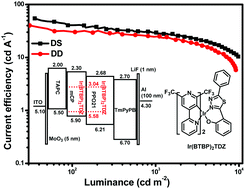Photoluminescence and electroluminescence of an iridium(iii) complex with 2′,6′-bis(trifluoromethyl)-2,4′-bipyridine and 2-(5-phenyl-1,3,4-thiadiazol-2-yl)phenol ligands†
Abstract
Using electron transport units containing 2′,6′-bis(trifluoromethyl)-2,4′-bipyridine as the main ligand and 2-(5-phenyl-1,3,4-thiadiazol-2-yl)phenol as the ancillary ligand, an iridium(III) complex (Ir(BTBP)2TDZ) was synthesized, characterized and investigated in detail. The greenish yellow photoluminescence spectrum peaks at 551 nm with a quantum yield of 44%. Organic light-emitting diodes (OLEDs) using Ir(BTBP)2TDZ as the emitter with a single light emitting layer (DS) and double light emitting layers (DD) were fabricated; the DS device exhibited better performances with a maximum current efficiency, power efficiency and external quantum efficiency of up to 54.5 cd A−1, 31.1 lm W−1 and 16.1%, respectively. The results suggest that the iridium complex with the 1,3,4-thiadiazole derivative has potential application in efficient OLEDs.



 Please wait while we load your content...
Please wait while we load your content...